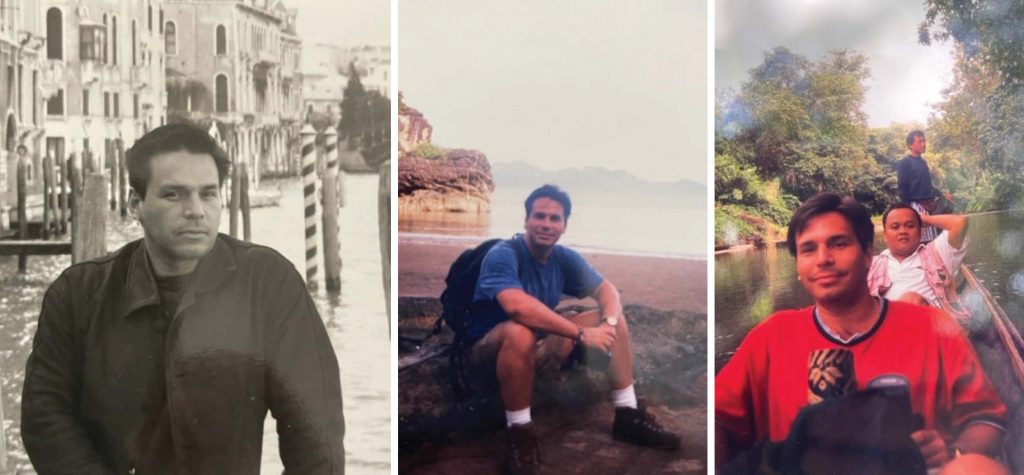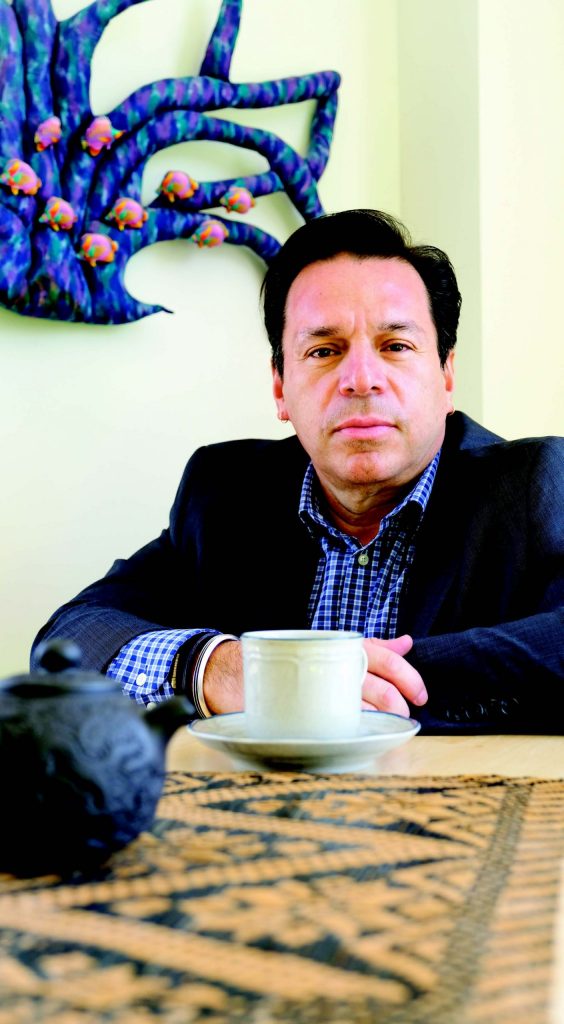Wander the halls of the Upper School on any given afternoon, and you’ll hear Spanish—or perhaps Italian—floating out of the doors of founding faculty member Vic Quesada-Herrera’s world languages classroom. You’ll find no random vocabulary drills here, no repetitive verb conjugations. Instead, assuming you can understand the language, you might be treated to a discussion of how themes from Greek mythology resonate in Costa Rican folklore, a collaborative critique of a Spanish contemporary art piece, or a debate on climate change and habitat loss in the Amazon.
You see, Quesada-Herrera doesn’t merely teach world languages; his aims are far loftier and more personal. He’s on a quest to cultivate empathetic and curious lifelong learners, those who are not only fluent in their target language, able to convey their thoughts and ideas, but also culturally literate and appreciative of cultures different than their own. How better to do that than as engaged global citizens exploring the world—its history, arts, cuisines, social issues, and more—in conversational Spanish, both in the classroom and abroad?
“When you learn a second language, the world has a different flavor, a different smell, a different taste, a different color. You enter through a window, a world that is not your own,” he muses, eyes lighting up.
“You gain a whole new perspective. You become more empathetic, accepting, and respectful of others. It makes you more global, your brain and sensibilities more malleable and flexible, open to new possibilities, to seeing things a new way.”
With language as his key, Quesada-Herrera has been throwing open those windows to other worlds his entire life. The lessons he has learned along the way—empathy, forging connections across differences, leaning into discomfort, resilience, and intelligent risk-taking—figure as prominently in his classrooms as his language expertise.
DISCOVERY DRIVEN
Quesada-Herrera’s passion for language and culture is deeply rooted, shaping his very approach to life. A self-proclaimed “hardcore learner” and consummate global citizen, he has pursued the smallest of curiosities as they have morphed into life-altering adventures spanning the globe.
As a young child in Costa Rica, a tiny spark—an early love of Australian television programming—inspired a yearning to learn English, kicking off a lifelong obsession with languages. After pursuing language study throughout high school, he entered the University of Costa Rica at the young age of 16, ultimately transferring to the University of Northern Iowa to earn a degree in linguistics and TESL.
“I wanted to go somewhere I had no choice but to speak English, where I couldn’t slip back into the comfort of Spanish,” he explains, foreshadowing the immersive approach he uses in his classroom today. He would return to Costa Rice after graduation, teaching English at a private university before settling in the United States.
Another seemingly small inspiration—a chance discovery of Proboscis monkeys made while poring over his mother’s nature magazines as a boy—would lead to a lifelong fascination with the Malaysian region they call home. Decades after first turning those well-worn pages, he would embark on a life-changing trip to Borneo to study nature. Living with a remote indigenous tribe, he was struck again with the unique vulnerability of connecting with a culture other than one’s own and reaped the rewards of giving himself over to a new cultural experience (just ask him about eating a ceremonial fish with a tribe elder).
Today, he delights in seeing students share similar awakenings in the World Language Exchange Program that he has helped shape. His enduring love for Malaysia and its inhabitants—human and otherwise— permeates his advanced Spanish classroom discussions about climate change and habitat preservation and fuels his outside interests in zoology. The ability to weave his interests into his curriculum contributes to his classroom’s vibrant energy, a palpable presence amongst the ever-expanding collection of books and art that line its walls.
Ever the adventurer, Quesada-Herrera enjoys regular trips to Italy (he visits as often as possible to keep his language skills fresh). In his element, he finds himself at the opposite end of the language spectrum, reveling in the joy of fluency—a gift he hopes to impart to his students.
“When I go to Italy, I’m in awe—immersed in it, enjoying every moment,” he offers. “Language is a tool to enjoy life. It allows us to connect and fully participate in the world. It inspires both compassion and curiosity, a sense of ‘Wow, there’s so much out there that I can see, that
I can open my eyes to, that I can experience.’ That joy, that authentic connection to the world—that is what I hope for my students.”
IMMERSIVE AUTHENTICITY
As with all Quesada-Herrera’s journeys, it was the pull of a new experience that first brought him to Cary Academy 25 years ago. Intrigued by the new technology-forward teaching environment, he was enthralled to put the countless lessons learned from his global explorations to good use in helping to develop CA’s world languages program.
“We knew from the beginning that we did not want to just teach out of a textbook or teach to a test,” explains Quesada-Herrera. We wanted to open that window to another world, another culture. We wanted students to be able to truly speak, to convey ideas in their second language.”
Immersion, both in language and culture, was deemed paramount. “I only communicate with my students in their target language. Not 85% of the time, but all the time, and not just in the advanced classes, but even at the most basic levels. Otherwise, it is too comfortable to switch to English; you must get uncomfortable to learn.”
He laughs, “I remember my first advanced students; I think they thought I didn’t know English. Now and then, our paths would cross outside campus, and they would try to speak to me in English; I would always respond in Spanish. Even now, I have alums that text me, but they always text me in Spanish.”
But language immersion was only one piece of the puzzle. From the outset, expeditionary travel has been a hallmark of the CA program, one made possible, in large part, by Quesada- Herrera. Collaborating with leadership, he cultivated partnerships with host institutions around the globe to help develop the World Language Exchange Program.
Over the years, he has been instrumental in transforming that program from the more tourist-based experiences that characterized his early trips with students to the dual exchange program we have today, in which students from CA change places with students from our partner institutions abroad. These deep cultural exchanges offer students the opportunity to develop confidence in their target language, as well as broaden their perspectives to develop a more nuanced understanding of the world.
The program’s evolution has been thoughtful and, for Quesada-Herrera, necessary—for the edification of both students and the broader community. “The dual exchange is so important—not only for our students, but also for the families that receive students from our Argentinian partner institutions,” he offers.
“Unfortunately, many people don’t understand the complexity of Hispanic identities. There is an assumption that if you are a Spanish-speaking person, then you are from one country, that you are Latin American, that all Spanish speakers are the same. Traveling as a local, and on the flip side, hosting a visiting student in your home—forges a connection. You experience the cultural similarities and differences, the nuances. It tears down stereotypes. And that is major.”
As CA has grown over the years, so has the need to expand world language offerings. Quesada-Herrera has been a leading voice in developing the advanced topical classes that are now CA signatures. They offer a welcome opportunity to inject his own interests—and those of his students’—into the curriculum, an approach that keeps his “sparkle” and love of teaching fresh.
“Language classes don’t have to be about language. You can study anything—it doesn’t matter; you are still practicing the language. To do it while learning about something that interests you, something that matters to you, makes it more vivid.”
He credits the variety of the advanced classes with increasing student engagement, appealing to those who might not identify, first and foremost, as language learners.
“My Global Warming and Vanishing Ecosystems class appeals to students interested in biology and ecology; they identify with that part of the class,” he offers as an example. “They can put aside the initial fear and discomfort of it being in a different language because they connect with their subject. They go for it.”

EVERYTHING IS CONNECTED
For Quesada-Herrera, that is what it is all about: helping students to forge those personal connections that bring language and culture to life in ways that are relevant to their lives, that open their eyes to new possibilities, and which are sustainable and pay dividends long after they leave his classroom.
It is a legacy that is not lost on his former students, many of whom regularly name him as having a defining impact on their CA experience.
“If I had to characterize Vic’s philosophy in a sentence, it’s todo está conectado—everything is connected,” reflects CA alum Julia Gong, ‘17, who remains in contact with Quesada- Herrera, reaching out when she is reminded of a poem or song that she learned in his class. “He has this neat way of finding and unveiling how concepts are interconnected. His philosophy is all about embracing the world and its beauty, seeing it through the lens of language and how it connects the world,” she offers.
Gong, who studied mathematical and computational science at Stanford University and currently works in artificial intelligence, still makes room in her life for language, much to Quesada- Herrera’s delight.
“I have pursued a very technical direction professionally, but I’ve retained this love for language because of what I learned in Vic’s classroom,” she offers. “I learned in his class to see the interconnectedness of the world—and that feeds into the interdisciplinarity and innovation I bring to my work, in the interplay of humanities and STEM.”
For Quesada-Herrera, nothing could be sweeter. “When I see students using the language in their lives, developing a real sense of confidence in speaking, in interacting with the world, it’s as if they are little butterflies that have been transformed from caterpillars. And now, they are spreading their wings, flying all over the place.”

